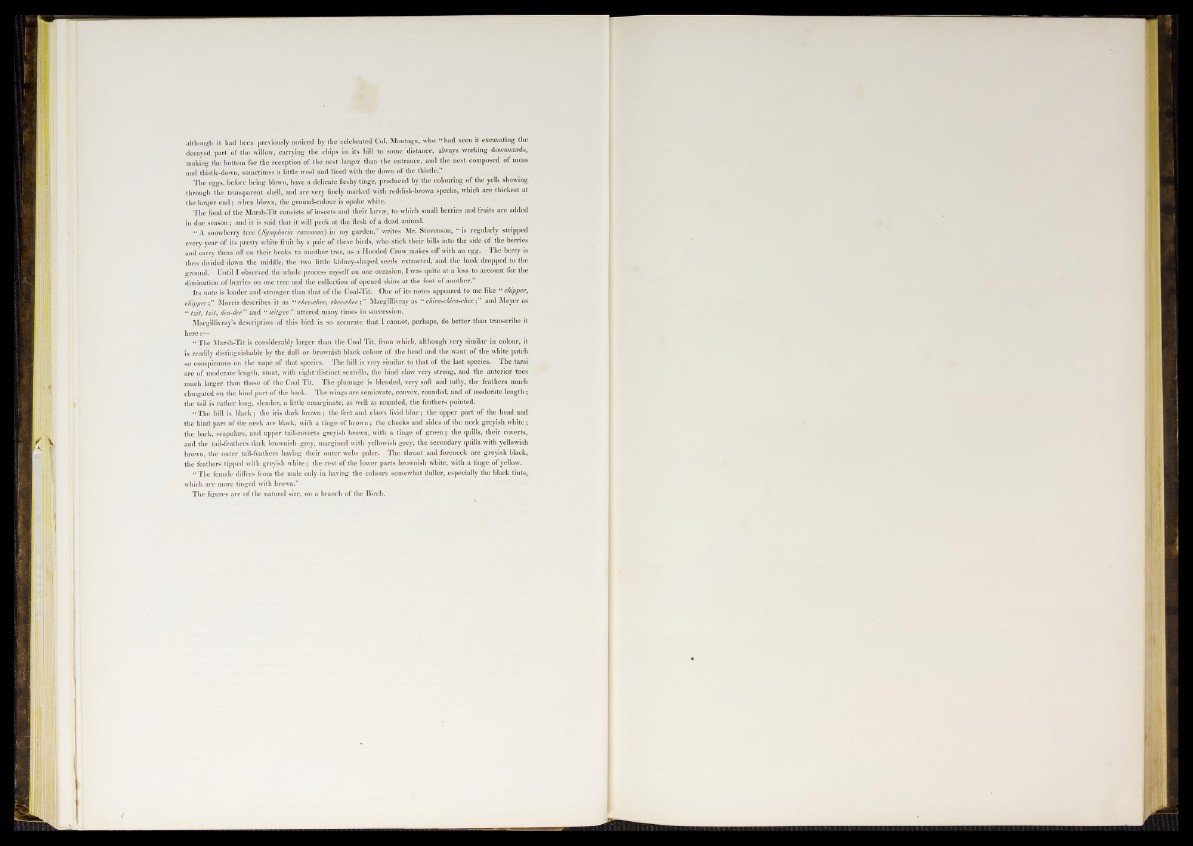
although it had been previously noticed by the celebrated Col. Montagu, who “ had seen it excavating the
decayed part of the willow, carrying the chips in its bill to some distance, always working downwards,
making the bottom for tbe reception o f the nest larger than the entrance, and the nest composed of moss
and thistle-down, sometimes a little wool and lined with the down of the thistle.
The eggs, before being blown, have a delicate fleshy tinge, produced by the colouring of the yelk showing
through the transparent shell, and are very finely marked with reddish-brown specks, which are thickest at
the larger e n d ; when blown, the ground-colour is opake white.
The food of the Marsh-Tit consists o f insects and their larvae, to which small berries and fruits are added
in due season; and it is said that it will peck at the flesh of a dead animal.
“ A snowberry tree ([Symphoria racemosa) in my garden,” writes Mr. Stevenson, “ is regularly stripped
every year of its pretty white fruit by a pair of these birds, who stick their bills into the side o f the berries
and carry them off on their beaks to another tree, as a Hooded Crow makes off with an egg. The berry is
then divided down the middle, the two little kidney-shaped seeds extracted, and the busk dropped to the
ground. Until I observed the whole process myself on one occasion, I was quite a t a loss to account for the
diminution of berries on one tree and the collection o f opened skins a t the foot o f another.”
Its note is louder and stronger than that of the Coal-Tit. One of its notes appeared to me like “ chipper,
chipper; ” Morris describes it as “ chee-chee, chee-chee;” Macgillivray as “ chica-chica-chee; ” and Meyer as
“ tzit, tzit, dea-dee” and “ wit g e e " uttered many times in succession.
Macgillivray’s description of this bird is so accurate that I cannot, perhaps, do better than transcribe it
h e re :—
“ The Marsh-Tit is considerably larger than the Coal Tit, from which, although very similar in colour, it
is readily distinguishable by the dull o r brownish black colour of the head and the want of the white patch
so conspicuous on the nape of that species. The bill is very similar to that of the last species. The tarsi
are of moderate length, stout, with eighfdistinct scutella, the hind claw very strong, and the anterior toes
much larger than those of the Coal Tit. The plumage is blended, very soft and tufty, the feathers much
elongated on the hind part o f the back. Tbe wings are semiovate, convex, rounded, and o f moderate len g th ;
tbe tail is rather long, slender, a little emarginate, as well as rounded, the feathers pointed.
“ The bill is black; the iris dark brown; the feet and claws livid blue; the upper p art o f the head and
the hind part of the neck are black, with a tinge of brown; the cheeks and sides of the neck greyish white;
the back, scapulars, and upper tail-coverts greyish brown, with a tinge o f g re e n ; the quills, their coverts,
V and the tail-feathers dark brownish grey, margined with yellowish grey, the secondary quills with yellowish
brown, the outer tail-feathers having their outer webs paler. The throat and foreneck are greyish black,
the feathers tipped with greyish white; the rest o f the lower parts brownish white, with a tinge o f yellow.
“ The female differs from the male only in having the colours somewhat duller, especially the black tints,
which are more tinged with brown.”
The figures are of the natural size, on a branch of the Birch.
II I